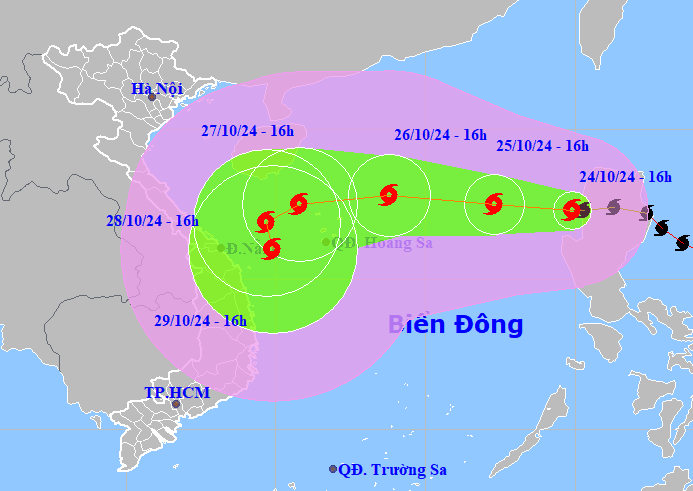Storm No. 6 is forecast to be strong, with very complex developments. Its direction of movement and wind level may change due to the impact of many weather patterns at sea.

On the afternoon of October 24, storm Trami entered the eastern sea of the North East Sea, becoming storm number 6 in 2024.
The storm is moving west at a speed of 15-20km/h. The strongest wind near the storm center is level 9, gusting to level 11.
According to the forecast of the National Center for Hydro-Meteorological Forecasting, in the next 24 to 48 hours, the storm will continue to strengthen, the strongest wind near the storm's center can reach level 11-12, gusting to level 14-15, moving west towards the Hoang Sa archipelago, then it can affect the offshore and coastal waters of the Central region provinces (from Ha Tinh to Binh Dinh) from October 27 to 29.
Trami is a storm that is forecast to be strong, very complex, its direction of movement and wind level may change due to the impact of many weather patterns at sea.
To proactively respond to storms and floods that may occur in the mainland of the Central region due to the impact of storms, the Prime Minister has issued an official dispatch requesting ministers and chairmen of provincial and municipal People's Committees to proactively organize close monitoring, update forecast information and the situation of storms, rains and floods to promptly direct and deploy response work according to the "four on-site" motto according to assigned functions and tasks, not to be passive or surprised to ensure safety of life and minimize property damage for people.
For localities, the Prime Minister requested the Chairmen of the People's Committees of provinces and cities to direct the review and update of response plans for natural disasters, storms and floods in the localities; based on the actual situation and the potential impact of storms and floods in the localities, proactively provide timely information, direct and guide people to respond to storms and floods.
Localities focus on ensuring safety for activities at sea and on islands: Organize inspections, counting, proactively informing and guiding vehicles and boats (including fishing boats, transport ships, and tourist boats) still operating at sea to know, not to enter or exit dangerous areas or to return to safe shelters; take measures to ensure safety for boats at anchorage areas.
During this time, localities will review and implement measures to ensure safety for tourism, aquaculture, and fishing activities at sea, estuaries, and coastal areas; resolutely evacuate people on cages, aquaculture huts to safe places before the storm directly affects them. Based on the specific situation, localities will proactively decide to ban fishing boats, transport ships, and tourist boats from going to sea.
Regarding ensuring safety in coastal and inland areas, localities should review and be ready to evacuate people from dangerous areas, especially those at risk of deep flooding, landslides, river mouths, and coastal areas.
Implement measures to ensure safety, limit damage to houses, warehouses, headquarters, public works, industrial parks, factories, dikes; protect agricultural production, prevent flooding in urban areas and industrial parks.
Control traffic, organize traffic flow, guide traffic, limit people from going out during storms and heavy rains to ensure safety.
Regarding ensuring safety in mountainous areas, localities must review and be ready to evacuate people in areas at risk of deep flooding, flash floods, and landslides; prepare forces, vehicles, equipment, and necessities according to the "four on-site" motto to be ready to respond to all situations.
Check and proactively take measures to ensure safety of reservoirs and downstream areas; arrange permanent forces ready to operate, regulate and handle situations.
The Prime Minister requested localities to control and guide safe traffic, especially through tunnels, overflows, deeply flooded areas, and areas with fast-flowing water; proactively arrange forces, materials, and means to overcome incidents, ensuring smooth traffic on main traffic routes; Prepare forces and means to promptly rescue and quickly overcome the consequences of storms and floods.
The Prime Minister assigned the Minister of Natural Resources and Environment to closely monitor, increase forecasts and warnings, and promptly update information on storm developments, floods, flash floods, and landslide risks so that relevant agencies and people can proactively deploy response measures.
Ministers of the Ministries of National Defense and Public Security direct forces stationed in the area to review response plans, proactively organize and deploy forces and means to be ready to support localities in responding to storms and floods, evacuating people, and conducting rescue operations.
Ministers of the Ministries of Transport, Industry and Trade and relevant ministries and branches, according to their state management functions and assigned tasks, shall proactively direct and coordinate with localities to deploy work to ensure safety of offshore oil and gas activities, mineral exploitation and power grid systems; ensure safe operation of hydroelectric reservoirs; ensure traffic safety according to regulations.
The Minister of Agriculture and Rural Development is responsible for organizing close monitoring of the situation, proactively directing the effective implementation of storm and flood prevention and control work according to assigned tasks and authority; ensuring the safety of dykes, dams, protecting agricultural production and aquaculture, and exploiting aquatic and marine products; promptly reporting and proposing to the Prime Minister issues beyond his authority.
The Prime Minister requested Vietnam Television, Voice of Vietnam, Vietnam News Agency and other media agencies to increase the time and promptly report on the developments of storms, floods and response work so that people know and proactively prevent and avoid them.